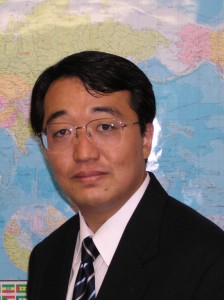緊張と統合:内村鑑三におけるキリスト教と日本の精神
このシリーズでは、私が1994年に執筆した統一神学大学院(Unification Theological Seminary)の神学課程修士論文(Divinity Thesis)を日英二か国語で掲載している。
序論の続き
内村鑑三は日本のキリスト教徒の中でも最も著名で魅力的な人物の一人であり、彼は実に真摯にキリスト教と日本文化を統合しようと努めた。どういうわけか彼は日本に神の摂理が働いていると信じ、日本の使命は西欧の諸国と他のアジア諸国の橋渡しをすることであると考えたのである。
内村の無教会運動は、キリスト教を西洋的な衣から解放しようという試みであり、それによって彼は福音に本来備わっている普遍性を主張しようとしたのである。無教会は意図的に教会の組織を回避することによって、日本人が西洋の宗教としてのキリスト教を超越することを可能にしたのである。内村は日本人の魂に福音の種を蒔く前に、人々の心を伝統的な日本の模範と美徳によって耕そうと欲した。従って彼はキリスト教を武士道の倫理および禅と統合しようと試みたのである。
内村は日本人であると同時にキリスト教徒であるという、自分が持つ二つのアイデンティティーの狭間で激しく葛藤した人物であった。内村を巻き込んだいわゆる不敬事件は、1891年に彼が教育勅語に記された明治天皇の宸署の前で敬礼することを拒んだことによって引き起こされた。この事件はキリスト教徒の忠誠に関する国家的次元の激しい論争に発展した。内村は愛国者であったが、彼の愛国心は自民族中心のナショナリズムではなかった。彼は純粋なキリスト教理想に基づいて、国際的な視野に立って自分の母国を愛したのである。彼のモットーは「二つのJ]すなわち Jesus と Japan を愛することであった。彼の古い聖書の表紙裏に書かれ、のちに彼の墓碑銘にもなった言葉は、彼がキリスト者としての責任を指向してナショナリズムを超越したことを象徴している。
I for Japan (われは日本のため)
Japan for the World (日本は世界のため)
The World for Christ (世界はキリストのため)
And all for God (そしてすべては神のため)
以上のような理由により、無教会主義キリスト教の本質および内村鑑三の生涯と思想を、キリスト教の日本文化への土着化のモデルとして検討することは、日本という文化的状況の中での司牧の概念と方法論に対する我々の理解を深めるのに役立つ。この論文は、西洋の人々に日本人に対する文化的な架け橋を掛ける道を提供するばかりでなく、より広い意味において土着化の過程に対する我々の理解を広め、そして深めるであろう。
以下に続く各章において扱う問題は、1)土着化の問題、2)無教会運動出現の歴史的背景、3)無教会運動における司牧の概念、4)キリスト教と日本文化の統合の方法、5)無教会運動の構造、6)無教会と日本社会、7)無教会運動の評価である。
Introduction (Cont.)
Kanzo Uchimura is one of the most prominent and attractive figures among Japanese Christians, who earnestly tried to integrate Christianity and Japanese culture. Somehow he believed in God’s providence working in Japan, and thought that the mission of Japan was to connect the Occidental countries with the other Asian countries.
Uchimura’s Mukyokai (non-church) movement is an attempt to free Christianity from its Western garment and thereby to affirm the universality believed inherent in the Gospel. Its deliberate avoidance of the institution of the church had enabled the Japanese to transcend Christianity as a Western religion. Uchimura wanted to cultivate people’s spirit by traditional Japanese examples and virtues in order for their soul to be seeded with the Gospel; so he attempted to synthesize Christianity with Bushido ethics and Zen Buddhism.
Uchimura was a person who really struggled between his two identities: one is Japanese, the other is Christian. The Lese Majesty Incident (fukei jiken) which involved him was caused by his refusal in 1891 to bow before the Imperial signature affixed to the Imperial Rescript on Education (Kyoiku Chokugo). This led to a fierce nationwide controversy over the loyalty of Christians. Although he was a patriotic person, his patriotism was not an ethnocentric nationalism. He loved his mother country within the international context, based on a pure Christian ideal. His motto was to love “two Js,” which means Jesus and Japan. The words written in the back of the cover of his old Bible, and also engraved on hid gravestone symbolize a transcendence of nationalism in the direction of Christian responsibility:
I for Japan
Japan for the World
The World for Christ
And all for God.
From the reasons mentioned above, to examine the essence of the Mukyokai Christianity and Kanzo Uchimura’s life and thought as a model of indigenization of Christianity in Japanese culture is useful for deepening our understanding of the concept and methods of ministry in Japanese cultural context. This works will not only provide a way for western people to make a cultural bridge with Japanese people but also increase and deepen our understanding of indigenization processes in more broader sense.
In following chapters, will deal with 1) the problem of indigenization 2) the historical background in which the Mukyokai movement emerged; 3) concept of ministry in the Mukyokai movement; 4) the way of synthesis of Christianity and Japanese culture; 5) Structure of the Mukyokai movement; 6) the Mukyokai and Japanese society; and then 7) evaluate the Mukyokai movement.
